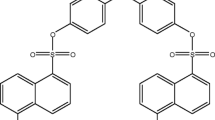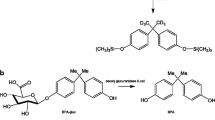Abstract
A selective and highly sensitive liquid chromatography–tandem mass spectrometry method has been developed and validated for determination of Bisphenol A (BPA) in human urine using labeled d6-BPA as internal standard. BPA was purified from human urine by affinity chromatography on solid extraction AFFINIMIP® Bisphenol A cartridges, based on molecularly imprinted polymers. After purification, the samples were analyzed on a Phenomenex Kinetex 100 × 4.6 mm, 2.6 μm particle PFP reversed-phase HPLC column, coupled to a triple quadrupole mass spectrometer by an electrospray ion source. Analyses were performed in the multiple reaction monitoring mode and negative ionization; the product ions at 133.2 and 212.1 m/z for BPA and at 138.2 and 215.0 m/z for d6-BPA were monitored to assess unambiguous identification. The linearity of the detector response was verified in human urine over the concentration range 0.100–200 ng/mL. The detection limit was calculated as 0.03 ng/mL and the limit of quantification of the method is 0.10 ng/mL. This LC/ESI-MS/MS method was in-house validated evaluating specificity, trueness, within-day and between-days precision. The mean recoveries of BPA from spiked urine samples were higher than 94 % and good reproducibility (relative standard deviations ≤ 8.1 %) was observed. The developed method was applied to a pilot study involving 105 children, aged from 6 to 14 years (16 normal weight and 89 obese children), from the Regione Campania (Southern Italy). The aim of this study was to determine the concentrations of BPA in urine of children and possible correlations with childhood obesity.




Similar content being viewed by others
References
Gore AC (2007) Introduction to endocrine-disrupting chemicals. Endocrine-disrupting chemicals: from basic research to clinical practice. Contemporary endocrinology. Humana Press, New York
Lang IA, Galloway TS, Scarlett A, Henley WE, Depledge M, Wallace RB, Melzer D (2008) Association of urinary Bisphenol A concentration with medical disorders and laboratory abnormalities in adults. JAMA 300:1303–1310
O’Connor JC, Chapin RE (2003) Critical evaluation of observed adverse effects of endocrine active substances on reproduction and development, the immune system, and the nervous system. Pure Appl Chem 75:2099–2123
Okada H, Tokunaga T, Liu X, Takayanagi S, Matsushima A, Shimohigashi Y (2008) Direct evidence revealing structural elements essential for the high binding ability of Bisphenol A to human estrogen-related receptor-gamma. Environ Health Perspect 116:32–38
Rubin Beverly S (2011) Bisphenol A: an endocrine disruptor with widespread exposure and multiple effects. J Steroid Biochem Mol Bio 127:27–34
EFSA (European Food Safety Authority) (2008) Toxicokinetics of Bisphenol A—scientific opinion of the panel on food additives, flavourings, processing aids and materials in contact with food (AFC). Available at: http://www.efsa.europa.eu/en/scdocs/scdoc/759.htm. July 2008.
EFSA (European Food Safety Authority) (2010a) Scientific opinion on Bisphenol A: evaluation of a study investigating its neurodevelopmental toxicity, review of recent scientific literature on its toxicity and advice on the Danish risk assessment of Bisphenol A of the EFSA Panel on Food Contact Materials, Enzymes, Flavourings and Processing Aids (CEF) on request from the European Commission, Questions No. EFSAQ-2009-00864, EFSA-Q-2010-01023 and EFSA-Q-2010-00709, adopted on 23rd September 2010. EFSA J 8:1829, 1–116. Available at: http://www.efsa.europa.eu/en/scdocs/scdoc/1829.htm. September 2010.
EFSA (European Food Safety Authority) (2010b) Statistical re-analysis of the Biel maze data of the Stump et al (2010) study: “Developmental neurotoxicity study of dietary Bisphenol A in Sprague–Dawley rats”. Question No. EFSA-Q-2010-01142. Adopted: 30 September 2010. EFSA J 8:1836, 1–67. Available at: http://www.efsa.europa.eu/fr/efsajournal/pub/1836.htm. September 2010.
Willhite CC, Ball GL, McLellan CJ (2008) Derivation of a Bisphenol A oral reference dose (RfD) and drinking-water equivalent concentration. J Toxicol Environ Health B Crit Rev 11:69–146
Braun JM, Kalkbrenner AE, Calafat AM, Yolton K, Ye X, Dietrich KN, Lanphear BP (2011) Impact of early-life Bisphenol A exposure on behavior and executive function in children. Pediatrics 128:873–882
Duty SM, Mendonca K, Hauser R, Calafat AM, Ye X, Meeker JD, Ackerman R, Cullinane J, Faller J, Ringer S (2013) Potential sources of Bisphenol A in the neonatal intensive care unit. Pediatrics 131:483–489
Geens T, Aerts D, Berthot C, Bourguignon JP, Goeyens L, Lecomte P, Maghuin-Rogister G, Pironnet A-M, Pussemier L, Scippo ML, Van Loco J, Covaci A (2012) A review of dietary and non-dietary exposure to Bisphenol-A. Food Chem Toxicol 50:3725–3740
Kuo HW, Ding WH (2004) Trace determination of Bisphenol A and phytoestrogens in infant formula powders by gas chromatography–mass spectrometry. J Chromatogr A 1027:67–74
Le HH, Carlson EM, Chua JP, Belcher SM (2008) Bisphenol A is released from polycarbonate drinking bottles and mimics the neurotoxic actions of estrogen in developing cerebellar neurons. Toxicol Letters 176:149–156
Vandenberg LN, Hauser R, Marcus M, Olea N, Welshons WV (2007) Human exposure to Bisphenol A (BPA). Repr Toxicol 24:139–177
Arakawa C, Fujimaki K, Yoshinaga J, Imai H, Seriza WAS, Shiraishi H (2004) Daily urinary excretion of Bisphenol A. Environ Health Prevent Med 9:22–26
Inoue H, Yokota H, Makino T, Yuasa A, Kato S (2001) Bisphenol A glucuronide, a major metabolite in rat bile after liver perfusion. Drug Metab Disps 29:1084–1087
Koch HM, Kolossa-Gehring M, Schröter-Kermani C, Angerer J, Brüning T (2012) Bisphenol A in 24 h urine and plasma samples of the German Environmental Specimen Bank from 1995 to 2009: a retrospective exposure evaluation. J Expo Sci Environ Epidemiol 22:610–616
Völkel W, Colnot T, Csanády GA, Filser JG, Dekant W (2002) Metabolism and kinetics of Bisphenol A in humans at low doses following oral administration. Chem Res Toxicolol 15:1281–1287
Ginsberg G, Rice DC (2009) Does rapid metabolism ensure negligible risk from Bisphenol A? Environ Health Perspect 117:1639–1643
Geens T, Neels H, Covaci A (2012) Distribution of Bisphenol-A, triclosan and n-nonylphenol in human adipose tissue, liver and brain. Chemosphere 87:796–802
Pritchett JJ, Kuester RK, Sipes IG (2002) Metabolism of Bisphenol A in primary cultured hepatocytes from mice, rats and humans. Drug Metab Dispos 30:1180–1185
Vandenberg LN, Chahoud I, Heindel JJ, Padmanabhan V, Paumgartten FJR, Schoenfelder G (2010) Urinary, circulating, and tissue biomonitoring studies indicate widespread exposure to Bisphenol A. Environ Health Perspect 118:1055–1070
Chen M, Tao L, Collins EM, Austin C, Lu C (2012) Simultaneous determination of multiple phthalate metabolites and Bisphenol-A in human urine by liquid chromatography-tandem mass spectrometry. Chromatogr B Anal Technol Biomed Life Sci 904:73–80
Inoue K, Kawaguchi M, Funakoshi Y, Nakazawa H (2003) Size-exclusion flow extraction of Bisphenol A in human urine for liquid chromatography–mass spectrometry. J Chromatogr B Anal Technol Biomed Life Sci 798:17–23
Jing X, Bing S, Xiaoyan W, Xiaojie S, Yongning W (2011) A study on Bisphenol A, nonylphenol, and octylphenol in human urine samples detected by SPE-UPLC-MS. Biomed Environ Sci 24:40–46
Min S, Yong-Heng C, Xiao-Yu L (2012) Consecutive online separation and determination of polybrominated diphenyl ethers, phthalate esters and Bisphenol A in human serum by gas chromatography–mass spectrometry. Fenxi Huaxue/ Chinese J Anal Chem 40:1139–1146
Ouchi K, Watanabe S (2002) Measurement of Bisphenol A in human urine using liquid chromatography with multi-channel coulometric electrochemical detection. J Chromatogr B 780:365–370
Poorahong S, Thammakhet C, Thavarungkul P, Kanatharana P (2013) Online in-tube microextractor coupled with UV–vis spectrophotometer for Bisphenol a detection. J Environ Sci Health - Part A Toxic/Hazardous Subs Environ Eng 48:242–250
Schmidt L, Müller J, Göen T (2013) Simultaneous monitoring of seven phenolic metabolites of endocrine disrupting compounds (EDC) in human urine using gas chromatography with tandem mass spectrometry. Anal Bioanal Chem 405:2019–2029
Völkel W, Bittner N, Dekant W (2005) Quantitation of Bisphenol A and Bisphenol A glucuronide in biological samples by high performance liquid chromatography–tandem mass spectrometry. Drug Metab Dispos 33:1748–1757
Pichon V, Chapuis-Hugon F (2008) Role of molecularly imprinted polymers for selective determination of environmental pollutants—a review. Anal Chem Acta 622:48–61
vom Saal FS, Myers JP (2008) Bisphenol A and risk of metabolic disorders. JAMA 300:1353–1355
Miao M, Yuan W, Zhu G, He X, Li DK (2011) In utero exposure to Bisphenol-A and its effect on birth weight of offspring. Reprod Toxicol 32:64–68
Newbold RR, Padilla-Banks E, Jefferson WN, Heindel JJ (2008) Effects of endocrine disruptors on obesity. Int J Androl 31:201–207
Wang T, Li M, Chen B, Xu M, Xu Y, Huang Y, Lu J, Ning G (2012) Urinary Bisphenol A (BPA) concentration associates with obesity and insulin resistance. J Clin Endocrinol Metab 97:223–227
Trasande L, Attina TM, Blustein J (2012) Association between urinary Bisphenol A concentration and obesity prevalence in children and adolescents. JAMA 308:1113–1121
Markham DA, Waechter JM, Wimber M, Rao N, Connolly P, Chuang JC, Hentges S, Shiotsuka RN, Dimond S, Chappelle AH (2010) Development of a method for the determination of Bisphenol A at trace concentrations in human blood and urine and elucidation of factors influencing method accuracy and sensitivity. J Anal Toxicol 34:293–303
Ye X, Kuklenyik Z, Needham LL, Calafat AM (2005) Quantification of urinary conjugates of Bisphenol A, 2,5-dichlorophenol, and 2-hydroxy-4-methoxybenzophenone in humans by online solid phase extraction–high performance liquid chromatography–tandem mass spectrometry. Anal Bioanal Chem 383:638–644
Cacciari E, Milani S, Balsamo A, Spada E, Bona G, Cavallo L, Cerutti F, Gargantini L, Greggio N, Tonini G, Cicognani A (2006) Italian cross-sectional growth charts for height, weight and BMI (2 to 20 yr). J Endocrinol Investig 29:581–593
Kosarac I, Kubwabo C, Lalonde K, Foster W (2012) A novel method for the quantitative determination of free and conjugated Bisphenol A in human maternal and umbilical cord blood serum using a two-step solid phase extraction and gas chromatography/tandem mass spectrometry. J Chromatogr B Anal Technol Biomed Life Sci 898:90–94
Liao C, Kannan K (2012) Determination of free and conjugated forms of Bisphenol A in human urine and serum by liquid chromatography–tandem mass spectrometry. Environ Sci Technol 46:5003–5009
Maragou NC, Makria A, Lampib EN, Thomaidisa NS, Koupparis MA (2006) Determination of Bisphenol A in milk by solid phase extraction and liquid chromatography–mass spectrometry. J Chromatogr A 1129:165–173
Miao M, Yuan W, HeY ZZ, Wang J, Gao E, Li G, Li DK (2011) In utero exposure to Bisphenol-A and anogenital distance of male offspring. Birth Defects Res Part A—Clin Mol Teratol 91:867–872
Acknowledgments
We thank all the donors for kindly providing urine samples for this study. This work was supported by the Italian Ministry of Health/IZSM (Portici, (NA) Italy) within the projects “Food and environmental safety: the problem of the endocrine disruptors” and by the MIUR (FIRB for young researchers 2008—Diano).
Author information
Authors and Affiliations
Corresponding author
Rights and permissions
About this article
Cite this article
Nicolucci, C., Rossi, S., Menale, C. et al. A high selective and sensitive liquid chromatography–tandem mass spectrometry method for quantization of BPA urinary levels in children. Anal Bioanal Chem 405, 9139–9148 (2013). https://doi.org/10.1007/s00216-013-7342-y
Received:
Revised:
Accepted:
Published:
Issue Date:
DOI: https://doi.org/10.1007/s00216-013-7342-y




